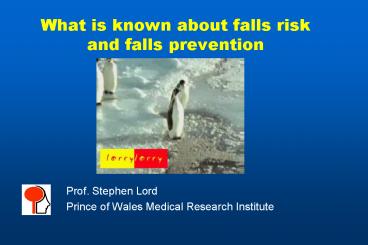What is known about falls risk and falls prevention - PowerPoint PPT Presentation
1 / 27
Title:
What is known about falls risk and falls prevention
Description:
What is known about falls risk and falls prevention Prof. Stephen Lord Prince of Wales Medical Research Institute Why are falls a problem? Falls are very common Falls ... – PowerPoint PPT presentation
Number of Views:1191
Avg rating:3.0/5.0
Title: What is known about falls risk and falls prevention
1
What is known about falls risk and falls
prevention
- Prof. Stephen Lord
- Prince of Wales Medical Research Institute
2
Why are falls a problem?
- Falls are very common
- Falls contribute to mortality and morbidity
- Falls are costly
- Falls affect lifestyle choices and the
independence of older people
3
Why are falls a problem?
- Approx. 30 of people 65 years and older living
in the community fall at least once per year. The
rate is higher for people in residential aged
care (40-50) - Falls are listed in the top three causes of
disability world wide - Leading cause of injury-related death and
hospitalisation in people aged 65 years and over.
Falls account for 4 of all hospital admissions
in this age group - By 2051 one quarter of the Australian population
will be aged 65 years and over (ABS 1997)
4
Consequences of falls
- 5-15 of falls result in major injuries - soft
tissue damage, head trauma, dislocations and
fractures - Reduced quality of life and independence- due to
disability, loss of confidence and restriction of
activity - Can result in the placement of older person in
residential aged care - Can result in death- 1000 people died in
Australia in 2000-2001
5
Location of falls
- 50 of falls occur in and around a persons own
home, the rest occur in public places and other
peoples homes - Most falls occur on level surfaces in commonly
used rooms- bedroom, living room, kitchen - Many falls do not involve an obvious
environmental hazard such as a loose rug or
slippery floor
6
Risk factors for falls
7
NSW Health Projected Costs to 2050
8
Causes of Falls
Trip 39.7
Slip 13.2
Unsure 14.3
Balance 20.8
Weak legs 5.5
Dizzy 5.2
Faint 1
9
Contrast sensitivity - MET
Melbourne Edge Test
10
Lower Limb Strength
11
Reaction Time- Hand Foot
12
Maximal Balance Range
13
Fear of falling
- Effects
- 29 to 92 in those who have suffered previous
falls - 12 to 65 in those who have not
- Associated with
- Poor balance, reduced strength, poor health
status, frailty, poor balance, immobility,
reduced quality of life , pain, anxiety,
depression and isolation
14
Falls prevention - What works?
High level balance exercise in groups or at home (functional balance exercises, Tai Chi)
Occupational therapy interventions in high risk populations
Cataract surgery
Withdrawal of sleeping tablets / tranquilisers
Pacemakers for black-out type falls
Multidisciplinary assessment of high risk populations
Comprehensive geriatric assessment in nursing homes
Targeted interventions in hospitals
Community populations
15
What does this mean for me?How can I reduce my
risk of falling?
16
(No Transcript)
17
Strength and balance - exercise
- Before starting get a medical clearance from your
GP - Carry out at least 2-3 times per week
- Start at a comfortable level and gradually
increase the intensity of the exercise as you
improve - Warm up - 5 minutes (walking, moving arms and
legs) - Conditioning period - strengthening, balance,
flexibility, endurance and co-ordination
activities - Cool down - 5-10 minutes (stretches, slow
movements) - It takes time for improvements to become apparent
- JOIN A GROUP EXERCISE PROGRAM
18
Strength training
Front Knee Strengthening
Back Knee Strengthening
Side Hip Strengthening
Try and use ankle weights whenever possible.
People aged 80 and over will start with 1-2 Kg.
Need to be able to do 8-10 reps before fatigue.
19
Balance exercises
Backwards walking (with/without support)
Ensure person can recover balance using lower
limb strategies before prescribing exercise
without support
20
Medical care
- Maintain regular visits to your GP for treatment
of any conditions that can lead to falls - Manage your medicines minimise use of sleeping
tablets and tranquilisers. These medications
double the risk of falls!
21
Eye sight
- wear single lens glasses, not bifocals or
multifocals when outside - wear a hat and/or sunglasses when out in the sun
to reduce glare - have eyes checked by a specialist every 12 months
- make sure your home is well lit, especially when
getting up at night - have cataracts removed if recommended by eye
specialist
22
Bi- and Multifocal glasses
23
Unsteady balance and numb legs
- wear safe shoes
- make sure you have been tested for diabetes
- take particular care on rough, uneven ground
- avoid dimly lit areas
- use a walking stick or umbrella as a sensor to
give feedback about the contour of the ground
24
Unsafe shoes
25
Shoe features that facilitate balance
firm fit
26
The environment
- ensure your home is well lit
- mop up spillages on floors to avoid slips
- install hand rails near stairs if necessary
- report fall hazards (eg. cracked footpaths) in
public places to local council etc
27
(No Transcript)

